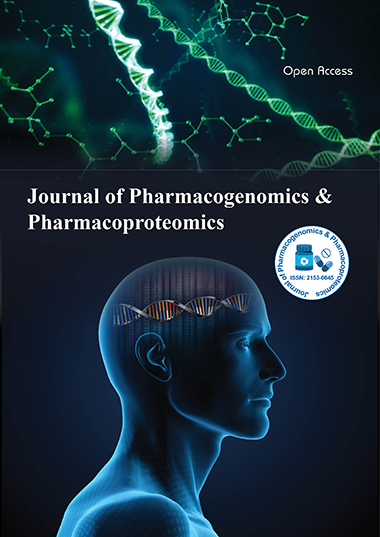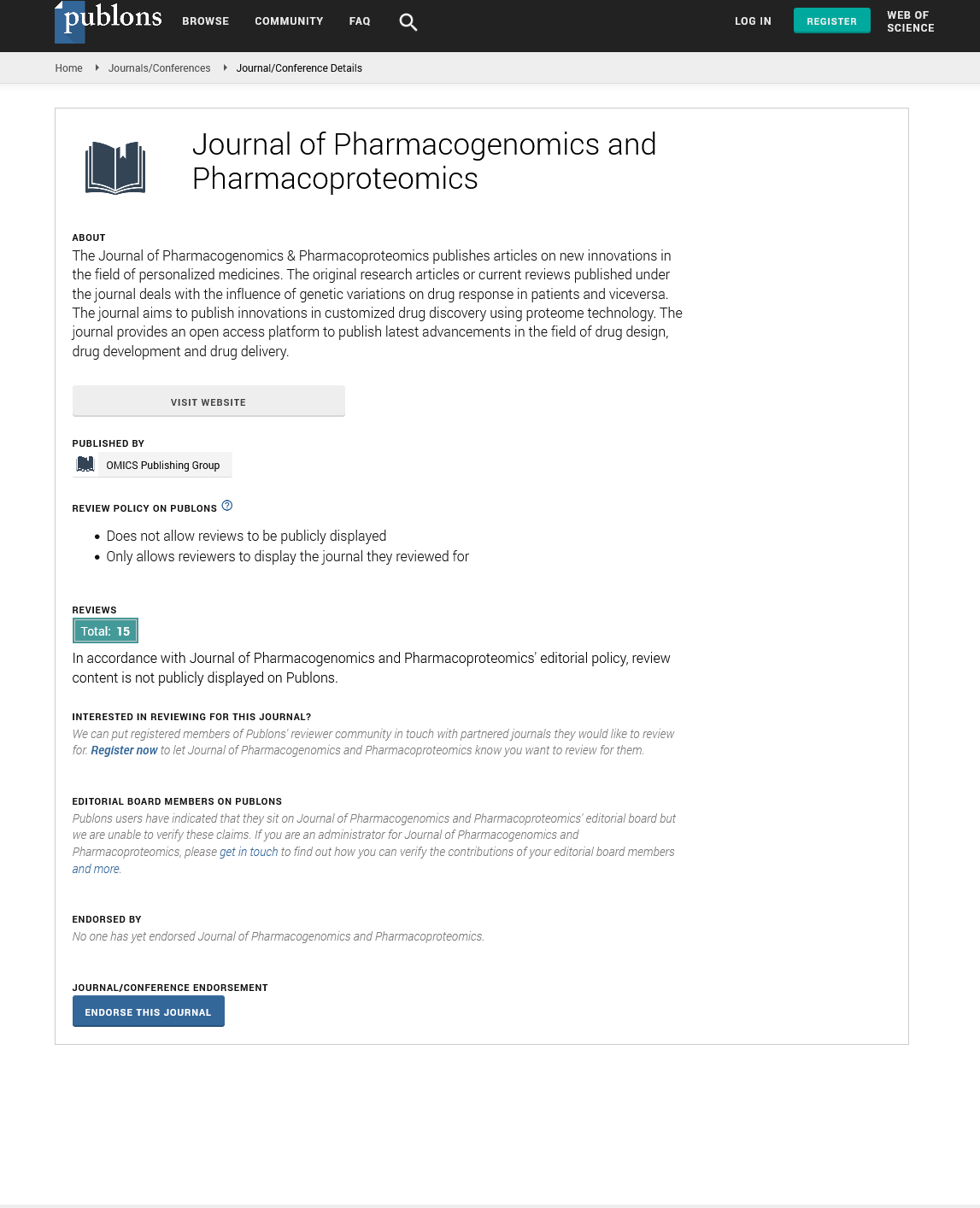Indexed In
- Open J Gate
- Genamics JournalSeek
- Academic Keys
- JournalTOCs
- ResearchBible
- Electronic Journals Library
- RefSeek
- Hamdard University
- EBSCO A-Z
- OCLC- WorldCat
- Proquest Summons
- SWB online catalog
- Virtual Library of Biology (vifabio)
- Publons
- MIAR
- Euro Pub
- Google Scholar
Useful Links
Share This Page
Journal Flyer

Open Access Journals
- Agri and Aquaculture
- Biochemistry
- Bioinformatics & Systems Biology
- Business & Management
- Chemistry
- Clinical Sciences
- Engineering
- Food & Nutrition
- General Science
- Genetics & Molecular Biology
- Immunology & Microbiology
- Medical Sciences
- Neuroscience & Psychology
- Nursing & Health Care
- Pharmaceutical Sciences
Commentary - (2024) Volume 15, Issue 4
Genetic Polymorphisms in CYP450 Enzymes: Implications for Drug Interaction Risk and Therapeutic Outcomes
Received: 25-Nov-2024, Manuscript No. JPP-24-27910; Editor assigned: 29-Nov-2024, Pre QC No. JPP-24-27910 (PQ); Reviewed: 16-Dec-2024, QC No. JPP-24-27910; Revised: 24-Dec-2024, Manuscript No. JPP-24-27910 (R); Published: 31-Dec-2024, DOI: 10.35248/2153-0645.24.15.115
Description
Cytochrome P450 (CYP450) enzymes are a superfamily of hemi containing enzymes responsible for the metabolism of a vast majority of drugs. Genetic polymorphisms in CYP450 genes significantly influence drug metabolism, leading to interindividual variability in drug response and susceptibility to Drug-Drug Interactions (DDIs). These genetic variations play a pivotal role in the emerging field of pharmacogenomics, with profound implications for optimizing therapeutic outcomes and minimizing Adverse Drug Reactions (ADRs). The CYP450 enzyme family includes numerous isoforms, of which CYP2D6, CYP2C19, CYP2C9, CYP3A4 and CYP1A2 are the most clinically relevant. Polymorphisms in these genes lead to diverse metabolic phenotypes: Poor Metabolizers (PMs), Intermediate Metabolizers (IMs), Extensive Metabolizers (EMs) and Ultra rapid Metabolizers (UMs). These phenotypes dictate the efficiency of drug metabolism and the likelihood of DDIs.
CYP2D6 is responsible for metabolizing approximately 25% of clinically used drugs, including antidepressants, antipsychotics, opioids and beta-blockers. Over 100 allelic variants of CYP2D6 have been identified, contributing to a wide range of metabolic activities. For instance, the CYP2D61 allele is associated with normal enzyme activity, whereas the CYP2D64 allele results in no functional activity. UMs carrying multiple copies of functional CYP2D6 alleles rapidly metabolize drugs, often resulting in sub therapeutic plasma levels and therapeutic failure. Conversely, PMs with non-functional alleles are at risk of drug accumulation and toxicity. CYP2C19 metabolizes Proton Pump Inhibitors (PPIs), antiplatelet agents such as clopidogrel and certain antidepressants. PMs of CYP2C19 exhibit reduced activation of clopidogrel, leading to diminished antiplatelet efficacy and increased cardiovascular risk. On the other hand, UMs may experience enhanced drug metabolism, reducing therapeutic effectiveness.
CYP2C9 polymorphisms influence the metabolism of Non Steroidal Anti-inflammatory Drugs (NSAIDs), oral hypoglycaemic agents and warfarin. The CYP2C92 and CYP2C93 alleles are associated with reduced enzyme activity, increasing the risk of drug toxicity, particularly with warfarin. PMs of CYP2C9 require lower warfarin doses to maintain therapeutic anticoagulation and prevent bleeding complications. CYP3A4 and CYP3A5 collectively metabolize nearly 50% of all drugs. Unlike other CYP450 enzymes, CYP3A4 exhibits fewer clinically significant polymorphisms. These polymorphisms impact the metabolism of immunosuppressants like tacrolimus, necessitating dose adjustments to achieve therapeutic levels. CYP1A2 is involved in the metabolism of caffeine, theophylline and certain antipsychotics. Polymorphisms in the CYP1A2 gene, influence enzyme infusibility. Genetic variability in CYP1A2 activity affects the risk of DDIs, particularly in individuals consuming inducers like tobacco or inhibitors such as fluvoxamine. DDIs occur when one drug affects the metabolism of another, often through inhibition or induction of CYP450 enzymes. Genetic polymorphisms exacerbate or mitigate these interactions, depending on the individual’s metabolic phenotype.
Drugs that inhibit CYP450 enzymes can increase plasma levels of substrates metabolized by the same enzyme, leading to toxicity. For example, co-administration of a CYP3A4 inhibitor like ketoconazole with a CYP3A4 substrate such as midazolam can result in profound sedation. Genetic variants that reduce CYP3A4 activity may further amplify this interaction, necessitating dose adjustments. Enzyme inducers enhance the activity of CYP450 enzymes, reducing plasma levels of co-administered drugs. For instance, rifampin induces CYP3A4, accelerating the metabolism of oral contraceptives and reducing their efficacy. Individuals with high baseline CYP3A4 activity due to genetic polymorphisms may experience even greater reductions in drug levels, highlighting the need for careful monitoring.
Polymorphisms in CYP2D6 significantly impact the metabolism of Tricyclic Antidepressants (TCAs). PMs of CYP2D6 are at risk of elevated TCA levels and associated toxicity, while UMs may require higher doses to achieve therapeutic effects.
Co-administration of CYP2D6 inhibitors, such as fluoxetine, can exacerbate these challenges, underscoring the importance of genotyping to guide treatment decisions. Understanding CYP450 polymorphisms is essential for tailoring drug therapy and mitigating DDIs in clinical practice. Pre-emptive genotyping can identify at-risk individuals and inform personalized treatment strategies. Genotyping for CYP450 variants can guide drug selection and dosing, particularly in medications with narrow therapeutic indices. For example, CYP2C9 genotyping can optimize warfarin dosing, reducing the risk of bleeding complications. ADRs are a major cause of morbidity and mortality, often linked to DDIs and genetic variability. Preemptive CYP450 testing can identify individuals at risk of ADRs, enabling clinicians to avoid high-risk drug combinations or adjust dosages accordingly.
CYP450 polymorphisms influence drug efficacy, particularly in conditions requiring precise pharmacokinetic control. For instance, CYP2C19 genotyping ensures optimal activation of clopidogrel, improving cardiovascular outcomes in patients with acute coronary syndromes. Despite the potential benefits, integrating CYP450 pharmacogenomics into routine clinical practice faces several barriers. The high cost and limited availability of genetic testing impede widespread adoption, particularly in resource-constrained settings. Interpreting Pharmacogenomic data requires specialized expertise and the lack of standardized guidelines complicates clinical decision-making. Most Pharmacogenomic studies have been conducted in populations of European descent, limiting the applicability of findings to other ethnic groups with different genetic profiles. Advances in Next-Generation Sequencing (NGS) and bioinformatics hold promise for overcoming these challenges. Comprehensive genotyping panels can assess multiple CYP450 variants simultaneously, providing a holistic view of an individual’s metabolic capacity. Integrating Pharmacogenomic data into electronic health records and clinical decision support systems can facilitate real-time application of genetic insights.
Population-specific research is crucial for expanding the relevance of pharmacogenomics across diverse ethnic groups. Collaborative efforts between academic institutions, healthcare providers and regulatory agencies can drive the development of evidence-based guidelines and policies for implementing pharmacogenomics in clinical practice. Genetic polymorphisms in CYP450 enzymes are critical determinants of drug metabolism, influencing the risk and severity of drug-drug interactions and therapeutic outcomes. Incorporating Pharmacogenomic testing into clinical practice offers a pathway to personalized medicine, optimizing drug therapy and minimizing adverse effects. On-going research and technological advancements will be instrumental in addressing existing challenges and realizing the full potential of CYP450 pharmacogenomics in improving patient care.
Citation: Lagely R (2024). Genetic Polymorphisms in CYP450 Enzymes: Implications for Drug Interaction Risk and Therapeutic Outcomes. J Pharmacogenom Pharmacoproteomics. 15:115.
Copyright: © 2024 Lagely R. This is an open-access article distributed under the terms of the Creative Commons Attribution License, which permits unrestricted use, distribution, and reproduction in any medium, provided the original author and source are credited.

